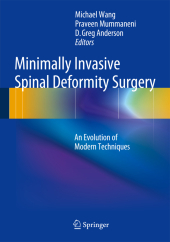 Neuerscheinungen 2014Stand: 2020-02-01 |
Schnellsuche
ISBN/Stichwort/Autor
|
Herderstraße 10
10625 Berlin
Tel.: 030 315 714 16
Fax 030 315 714 14
info@buchspektrum.de |

D. Greg Anderson, Praveen V. Mummaneni, Ethan Parten, Michael Wang
(Beteiligte)
Minimally Invasive Spinal Deformity Surgery
An Evolution of Modern Techniques
Herausgegeben von Wang, Michael; Parten, Ethan; Anderson, D. Greg; Mummaneni, Praveen V.
2014. x, 411 S. 87 SW-Abb., 176 Farbabb. 254 mm
Verlag/Jahr: SPRINGER, WIEN 2014
ISBN: 3-7091-1406-3 (3709114063)
Neue ISBN: 978-3-7091-1406-3 (9783709114063)
Preis und Lieferzeit: Bitte klicken
This book offers a thorough introduction to minimally invasive spine surgery (MISS) as a desirable option for managing advanced degenerative diseases. Shows how MISS techniques minimize blood loss, help reduce surgical site pain and speed recovery.
Contemporary spinal surgeons, whether orthopedic or neurosurgeons, are increasingly recognizing minimally invasive spine surgery (MISS) as a desirable option to manage advanced degenerative diseases. MISS techniques minimize blood loss, surgical site pain, and speed recovery. Thus, the marriage of MISS with adult spinal deformity was a natural one. Currently, the techniques, technologies, and education of surgeons have finally reached a point where MISS deformity surgeries are becoming commonplace. Nevertheless, the field is young enough that no comprehensive texts have addressed the unique challenges faced by surgeons exploring this evolving field. This book will fill the gap.
Deformity Surgery Principles: The epidemiology of adult spinal deformity and the aging population.- Classification scheme for scoliosis.- Indications for surgery.- Sagittal balance.- Lumbopelvic parameters.- Importance of the fractional curve.- Importance of the fractional curve.- Radiation safety.- Impact of MIS surgery on costs.- Percutaneous Segmental Fixation: Fluoroscopic techniques.- Image guidance.- Nuances of thoracolumbar screw placement.- Rod contouring, passage, and connection.- Percutaneous pelvic screw fixation.- Managing osteoporotic bone.- Use of cement in MIS deformity surgery.- Posterior Approaches: Interbody cage options.- Multi-level TLIF for spinal deformity.- Expandable cages for thoracic spinal deformity.- Expandable cages for lumbar spinal deformity.- Lumbar endoscopic fusion.- Osteotomy techniques.- Lateral Approaches: Thoracoscopic approaches.- Role of neuromonitoring.- Single incision approach to the lumbar spine.- Dual incision approach to the lumbar spine.- Which side to approach from?- Stand-alone lateral surgery for deformity.- Thoracic interbody surgery.-Complications of the lateral approach.- Dealing with the Lumbo-Pelvic Junction: Mini-open ALIF for fusing the lumbosacral junction.- Trans-sacral interbody fusion as an adjunct to anchoring constructs at the lumbosacral junction.- Minimally invasive sacroiliac joint fusion.- Achieving Intersegmental Arthodesis: Bone graft extenders.-Minimally invasive Wiltse approach posterolateral fusion.- Facet joint fusion.- Future Directions.
"It is a good reference guide for common MIS techniques that are routinely being applied to deformity surgery. ... this book provides an excellent roadmap not only to what techniques exist but also to how the spine community should go about its evaluation." (Alfred T. Ogden, Neurosurgery, Vol. 76 (6), June, 2015)
"Chapters describe concisely the technique, its indications and complications illustrated with intraoperative pictures or well drawn illustrations. ... the book is a valuable completion of the library of each practising spinal surgeon, spine fellow, and senior resident, since several minimal invasive spinal operative techniques and radiological concepts are concisely described." (Ronald Bartels, Acta Neurochirurgica, Vol. 157, January, 2015)


